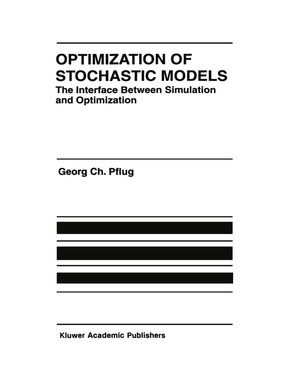Optimization of Stochastic Models - The Interface Between Simulation and Optimization
Vergleich zu frühere Preisbindung3
| Verlag | Springer |
| Auflage | 1996 |
| Seiten | 382 |
| Format | 17,4 x 23,9 x 2,6 cm |
| Gewicht | 735 g |
| Artikeltyp | Englisches Buch |
| Reihe | The Springer International Series in Engineering and Computer Science 373 |
| EAN | 9780792397809 |
| Bestell-Nr | 79239780E |
Stochastic models are everywhere. In manufacturing, queuing models are used for modeling production processes, realistic inventory models are stochastic in nature. Stochastic models are considered in transportation and communication. Marketing models use stochastic descriptions of the demands and buyer's behaviors. In finance, market prices and exchange rates are assumed to be certain stochastic processes, and insurance claims appear at random times with random amounts.
To each decision problem, a cost function is associated. Costs may be direct or indirect, like loss of time, quality deterioration, loss in production or dissatisfaction of customers. In decision making under uncertainty, the goal is to minimize the expected costs. However, in practically all realistic models, the calculation of the expected costs is impossible due to the model complexity. Simulation is the only practicable way of getting insight into such models. Thus, the problem of optimal de cisions can be seen as getting simulation and optimization effectively combined.
The field is quite new and yet the number of publications is enormous. This book does not even try to touch all work done in this area. Instead, many concepts are presented and treated with mathematical rigor and necessary conditions for the correctness of various approaches are stated.
Optimization of Stochastic Models: The Interface Between Simulation and Optimization is suitable as a text for a graduate level course on Stochastic Models or as a secondary text for a graduate level course in Operations Research.
Inhaltsverzeichnis:
1 Optimization.- 1.1 Stochastic optimization problems.- 1.2 Approximations.- 1.3 Bounds.- 1.4 Deterministic optimization procedures and their stochastic counterparts.- 1.5 Discrete Optimization.- 2 Discrete-Event processes.- 2.1 Markov chains with discrete time.- 2.2 Markov chains with continuous time.- 2.3 MARKOV PROCESSES WITH ARBITRARY STATE SPACE.- 2.4 Semi-Markov processes.- 2.5 Generalized Semi-Markov processes.- 2.6 Queueing processes.- 3 Derivatives.- 3.1 Derivatives of random processes.- 3.2 Derivatives of probability measures.- 3.3 Derivative concepts for Markov processes.- 4 Simulation and sensitivity estimation.- 4.1 Simulation techniques.- 4.2 Simulation of derivatives for random variables.- 4.3 Simulation of sensitivities for Markov Processes.- 4.4 Estimation of derivatives of Discrete-Event processes.- 5 Stochastic Approximation.- 5.1 Convergence and asymptotic distributions.- 5.2 Stopping times and confidence regions.- 5.3 DISCRETE STOCHASTIC APPROXIMATION.- 5.4 St ochastic Approximation versus the Response Surface Method.- 5.5 The convergence of the combined procedure.- A Metric spaces.- B Sequences and Series.- C Matrix Algebra.- D Derivatives.- E Convexity and convex projections.- F Set-wise Convergence.- G Duality and Lagrangians.- H Probability spaces and random variables.- I Convergence of random variables.- J The Wasserstein distance.- K Conditional expectations.- L Martingales.- M Choquet Theory.- N Coupling.

